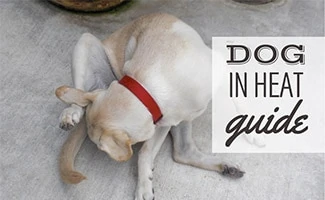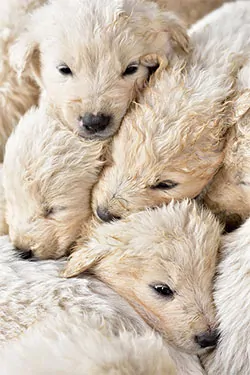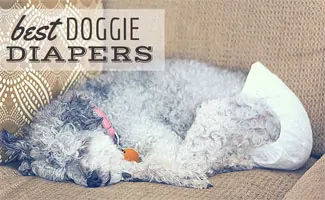What to Do When the Dog Is in Heat
 Heat, or estrus, is the time in the canine reproductive cycle when a female dog is ready to mate. Though this is a normal part of a female dog's life, it may not be straightforward for you to navigate. It's essential to get the information you need so you and your dog can get through this time together.
Heat, or estrus, is the time in the canine reproductive cycle when a female dog is ready to mate. Though this is a normal part of a female dog's life, it may not be straightforward for you to navigate. It's essential to get the information you need so you and your dog can get through this time together.
Article Overview
The Dog Heat Cycle
Female dogs experience their first heat cycle between four and 15 months of age. This time varies a lot by the dog's breed and size. Typically, dogs average two heat cycles a year, each about six months apart. It's the only time in your dog's life when she can get pregnant. Dogs can't get pregnant if they aren't in heat. (Note: A spayed dog will halt its heat cycles.)
The canine reproductive cycle, or heat cycle, has four stages:
 1. Proestrus: This beginning stage of the heat cycle is when your dog's body is getting ready to mate. Signs and symptoms of heat will begin, including bloody discharge and behavioral changes.
1. Proestrus: This beginning stage of the heat cycle is when your dog's body is getting ready to mate. Signs and symptoms of heat will begin, including bloody discharge and behavioral changes.
2. Estrus: The Estrus stage is what people consider the "heat" stage. At this point, your dog is ready to breed and is fertile. The bleeding will subside, and vaginal discharge turns more of white or yellowish. You may notice that she'll approach male dogs with her tail to the side and show signs of aggression toward female dogs.
3. Diestrus: In this stage, the body either returns to normal or progresses with pregnancy.
4. Anestrus: This stage is inactive, with no hormonal or sexual changes occurring.
What Are The Signs & Symptoms That Your Dog Is In Heat?
Here's a list of physical and behavioral changes you might notice when your dog's in heat.
- Agitated or restless behavior
- Bloody vaginal discharge
- Interest in male dogs
- Licking genitals excessively
- Loss of appetite
- More frequent urination
- Swollen vulva
- Tail tucking close to the body
Some dogs may also experience a "silent heat", in which they go through a normal heat cycle without displaying any of the above symptoms.
Do Dogs Have Periods?
During the proestrus stage, female dogs have a bloody vaginal discharge, much like humans during their period. They also experience many of the other symptoms of a period like hormonal and behavioral changes.
Behavior & Pain While In Heat
A dog's body experiences lots of changes when she's in heat. Because of these changes, your dog may experience some changes in behavior and even some pain. Much like humans, female dogs experience cramps and hormonal changes when their bodies are preparing to mate. Also, like humans, this can be uncomfortable and can make them feel irritable and emotional.
Be sure to consider your dog's feelings and needs during this time. A little extra love could go a long way. See our article on the best pain meds for dogs to see what's safe and what's not if you're thinking about treating your dog's pain during the heat cycle.
How Long Will My Dog Stay In Heat?
A typical heat cycle can last from two to four weeks. It can be shorter or longer, but if it goes much past four weeks, you should check with your vet to make sure everything is normal.
What Should I Do When My Dog's In Heat?
Here are five tips to protect your dog when she's in heat.
1. Allow your dog to rest: All the changes in your dog's body will wear her out. Give her plenty of time to rest.
2. Keep your dog in your yard: A fenced yard is the safest way to keep other dogs separate from yours. But don't let her out alone. Male dogs can smell her pheromones, the scent dogs produce when ready to mate, and be attracted.
3. If you have to take your dog out, keep her on a leash: During this time, your well-behaved pup may forget her obedience skills and try to escape to find herself a mate. Keeping her on a leash will reduce her chances of success.
4. Mask the scent of your dog while she's in heat: Keeping your house clean and covering your dog's bottom with a diaper will help control the enticing smell of a dog in heat. This essential oil-based spray is a great way to naturally mask any unpleasant odors. You can also use diluted essential oils like lavender or chamomile mixed with water to spray on your dog to conceal the scent.
5. Think about spaying your dog before her next heat: Spaying your dog is the only way to end the estrus cycle and keep your dog from going into heat again. Vet's do not typically spay while a dog is in heat (or for several weeks afterward). It is recommended to wait 6-8 weeks after the heat is over.
How Can I Contain The Mess?
 The heat cycle can be messy, but you can purchase a few items to help keep your home clean. You can have your dog wear a doggie diaper to control the discharge from getting on your furniture and floors. Our experts review the best diapers for dogs so you can weigh your options.
The heat cycle can be messy, but you can purchase a few items to help keep your home clean. You can have your dog wear a doggie diaper to control the discharge from getting on your furniture and floors. Our experts review the best diapers for dogs so you can weigh your options.
You may also want to consider disposable pads to line the diaper and disposable wipes that will help you clean your dog's genitals when she has discharge.
Spay Your Dog To End The Heat Cycle For Good
The one sure way to end the heat cycle for your dog is to spay her. Consider the benefits of spaying and neutering your dog. You may also want to consider a pet wellness plan, which may help cover the cost.
What If I Can't Afford To Have My Dog Spayed Or Neutered?
If you can't afford the cost to have your dog spayed or neutered, you may be eligible for some help. You can explore our article, financial assistance resources, which covers some options.
An Abnormal Heat Cycle
In this three-minute video from Heron Lakes Animal Hospital, Dr. Lera talks about Lily, a six-year-old Yorkie, her abnormal heat cycle, and pyometra.
The Heat Cycle And Other Puppy Concerns
Having a female dog means you may face her entering the heat cycle in her puppy years. It can be a challenging time, but you can help make sure you are ready to handle it, keeping her happy and safe.
However, the heat cycle is not the only challenge you will face with your puppy. Our experts give you a heads up on many of the most common puppy behavior problems you may encounter and give you tips to stop them before they begin.
Do you have any tips for handling your dog during the heat cycle?
About The Author: Julie Fritz

Julie is a writer and researcher for Canine Journal and the team's dental expert. With over 15 years in the dental field and her love of human's best friend, she has found a unique passion for learning all there is to know about dogs' dental health and brings that knowledge to our readers. She also enjoys writing in-depth breed-specific articles and researching products and information to help pet parents care for their pups.
Growing up, she enjoyed living in a house that always had a Brittany Spaniel and is very happy now when she gets to spoil the dogs in her life with love and snuggles. Her professional writing career began in 2012, and today, she enjoys writing about a variety of things, from blogging about her family to informative articles about dogs, technology, events, and healthcare.
In her free time, you might find her hiking, trail running, biking, or swimming. You might also find her in the kitchen, where she loves to cook and bake for her family and friends.
Disclaimer: This website contains reviews, opinions and information regarding products and services manufactured or provided by third parties. We are not responsible in any way for such products and services, and nothing contained here should be construed as a guarantee of the functionality, utility, safety or reliability of any product or services reviewed or discussed. Please follow the directions provided by the manufacturer or service provider when using any product or service reviewed or discussed on this website.
We are a participant in the Amazon Services LLC Associates Program, an affiliate advertising program designed to provide a means for us to earn fees by linking to Amazon.com and affiliated sites.
Disclaimer: The information provided through this website should not be used for diagnosing or treating a health problem or a disease. It is not a substitute for professional care. If you have or suspect you may have a health problem, you should consult your health care provider.
What to Do When the Dog Is in Heat
Source: https://www.caninejournal.com/dog-in-heat/
0 Response to "What to Do When the Dog Is in Heat"
Post a Comment